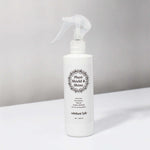Leca stands for lightweight, expanded, clay, aggregate. Leca is made out of clay, the material that terracotta is made of and it provides space for oxygen to flow through to plant roots. As plants absorb oxygen through their roots, leca provides pockets of airflow around the roots. This method is considered to be Semi Hydroponic. This hack prevents root rot and is especially ideal for the plant lover that doesn’t want to deal with the mess that comes with soil.
Leca does not have nutrients as soil and it is important to include a proper fertilizer for best results. We recommend our Lyfe Nutrient Fertilizer. Follow the directions advised on the product for best results. As this is a water soluble mixture that contains micronutrients, the plant growth will be optimized because the leca has excellent moisture retention properties. Our Grow In Leca Bundle is also available for purchase and is surely a must have for any plant enthusiasts.
Before using your leca, it is recommended that you give them a good wash. Some people boil the leca in water to rid them of any harmful elements, residue, dust or bacteria. Allow them to cool down and then to soak for about 6 hours. This process allows the terracotta material to absorb the water and will allow the beads to expand properly. Leca can be added to your plants soil and it will help your plant’s roots to maintain proper moisture and allow oxygen to circulate better.
Clean & Green
Leca is also used in propagating plants and it allows the root system to effectively absorb the needed oxygen so that your plant will flourish. You will also be less likely to get pests with leca as there is no soil to attract bugs. To propagate, prepare your cuttings. Take a strong, healthy cutting from the parent plant. Be sure that each cutting has at least 1 node. If there is no node, it’s not going to propagate. Allow the plant to callus over for a few hours or for an entire day depending on the type of plant. This will ensure healthy root growth.
Fill your planter with the soaked leca pebbles. Use a transparent container if you want to monitor the growth of the roots. Insert the cuttings of your plant into the leca beads. Be certain that the nodes are in contact with the leca for best results. This will promote healthy growth for the root systems that are to come. Plants that do really well in leca propagation are alocasia, hoyas, begonias and philodendrons. Do try your luck. Don’t be afraid to take risks by trying to propagate other plants.
Hydroponics Made Easy
Maintaining moisture is key. Add water to the container until it reaches about a third of the way up the leca layer. By doing this, you’re making sure that the roots will to receive the moisture they need without the cuttings sitting in the water. Monitor your plant. Place the plant in bright, indirect light and watch your plant thrive. Check your water levels and refill as needed so that it maintains the moisture.
With our stunning rose gold Propagation Station you can watch the process of your plants successful growth. You will see root development after a few weeks to a couple of months, depending on which plant you’re propagating. Be patient, follow the process and regularly change the water if you notice the beads turning a white color due to salt and mineral deposits over time. If algae starts to form in the container you also want to be sure to clean it properly. Rinse your leca well and enjoy the process.
Once you have a root system growing you may repot your plant accordingly in the new planter of your choice. Have you ever tried to propagate plants in leca before? Did you add fertilizer? Purchase our Grow in Leca Bundle that includes a glass vase, the leca beads and the Lyfe Fertilizer. We would love to hear from you. Tag us in your next post, story, reel or video & share your propagation results with us!
To learn more about leca, please click here to listen to CEO, Ofra Gaito speaking more about the benefits of using this great product for your house plants.
Let Love Bloom

